
Date: 2025-10-05 Page is: DBtxt003.php txt00017310
Military
The British Royal Navy
How modern technologically is the UK's Navy Fleet?
Peter Burgess
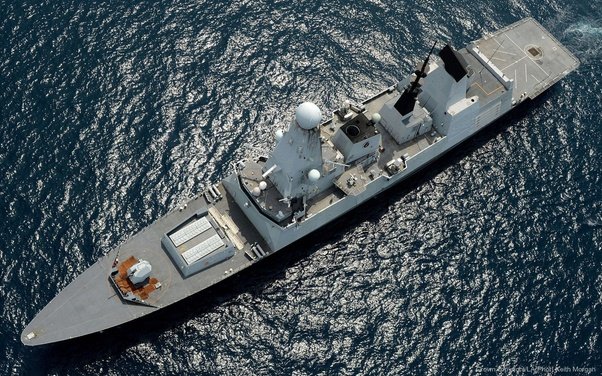
A 9,000 ton Type 45 ‘Daring’ class air defence destroyer. It’s very good. The main problem facing the RN is numbers not quality. Type 45 ‘Daring’ class air defence destroyers are large, relatively new and extremely capable. The PAAMS air defence system with its Sea Viper (Aster 15 and 30) missiles and SAMPSON radar is a world beater - they are getting a power generation upgrade right now and will probably get a mid-life update to enable an anti-ballistic missile capability using a new version of the Aster 30 missile. There are a few areas where these ships could be improved, not least by giving them some strike length Type 41 VLS tubes alongside the current Sylver 50 VLS used for Sea Viper - for anti-ship and land attack cruise missiles - and a 127mm gun.
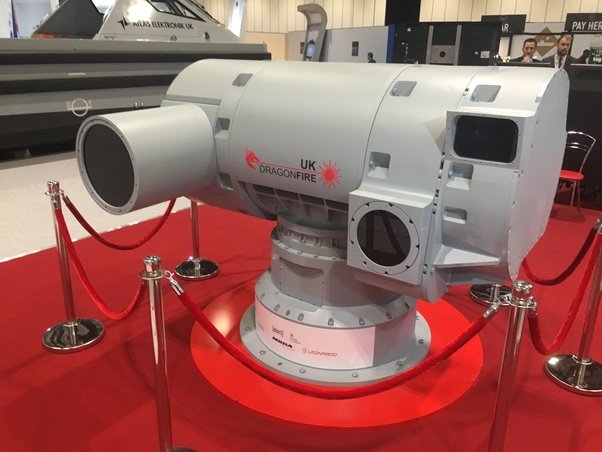
The Dragonfire directed energy (laser) weapon system under development for the Royal Navy. It’s designed to protect ships from anti-ship missiles. Type 23 ‘Duke’ class ASW frigates are older but have been constantly updated (a midlife update in the early 2000s has been followed-up by a recent LIFEX - life extension programme - with new air defence missile systems, improved open-architecture combat management and fire control systems, new ARTISAN 3D radars, helicopters and variable depth towed array sonars, in addition to new diesel generators and significant structural work to strengthen their hulls. The Type 26 ‘Town-class’ ASW frigates under construction are larger and even more capable.
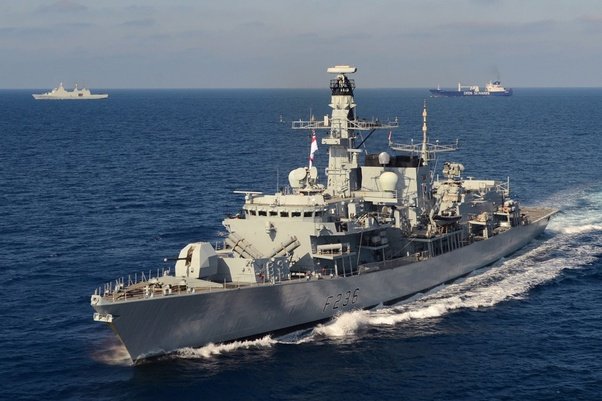
A 5,000 ton Type 23 ‘Duke’ class ASW frigate (after LIFEX). The escorts carry the excellent Merlin and Wildcat helicopters (Merlin for ASW and Wildcat for surface attack). Wildcat is brand new (replacing the older Lynx, from which it is derived) and is getting new Sea Venom and Martlet antiship missiles and Merlin has recently completed a major upgrade to its ASW system and is being integrated with the CROWSNEST airborne early warning radar system.
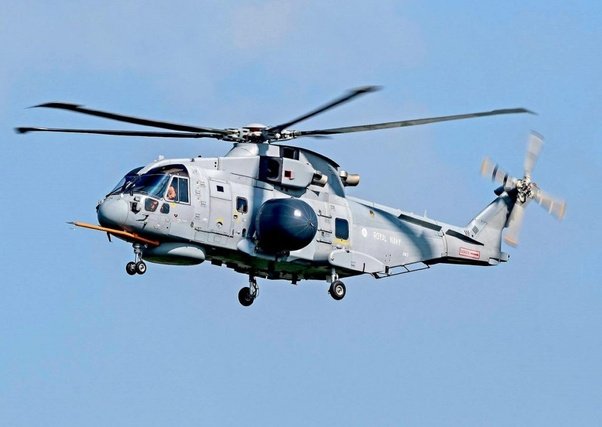
The Merlin HM2 helicopter with CROWSNEST radar system on its first flight last year. The Royal Navy has traditionally pioneered propulsion technologies, steam turbines in the early 20th century, Walther closed cycle engines in the 1950s, and nuclear reactors and gas turbines in the ‘60s and ‘70s. The Type 23, 26 and Type 45 escorts and the Queen Elizabeth carriers all have innovative and advanced combinations of diesel-electric and gas turbine power generation. The Type 45 introduced an advanced low-thermal signature and fuel efficient intercooled gas turbine to provide power to its combined diesel and gas all-electric powerplant, however the intercooler developed by General Electric did not function as well as expected in hot climates, and this has required an upgrade to the diesel power systems (three diesel generators instead of two). The carriers and Type 26 designs have reverted to a simpler but more powerful gas turbine and the Type 31e will use an all diesel arrangement. Current RN power generation research is focussed on adapting flywheel energy conservation technologies developed for Formula One racing to help meet the power-surge requirements of directed energy weapon systems.
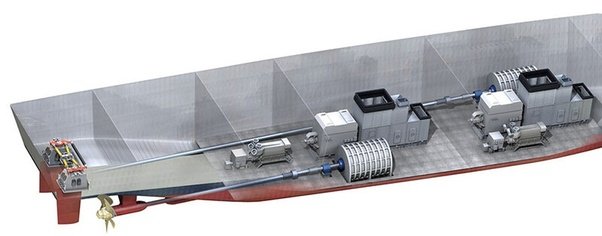
The Type 45 Destroyer uses an integrated electric propulsion (IEP) system. Two innovative intercooled Rolls Royce/Northrop Grumman WR-21 gas turbines and two Wartsila 2MW diesel generators provide electrical power for both the main engines and the ships systems. Problems with the WR-21’s intercooler has meant that these ships are now getting an additional diesel generator to increase available power. Type 26 frigates and Queen Elizabeth class carriers use the more conventionally designed but much more powerful Rolls Royce MT-30 gas turbines alongside diesel gensets. The RN’s submarines are all nuclear powered and best in class, and new SSNs and SSBNs are building. The SSBNs carry the latest Trident D4 ICBMs while the SSNs carry Tomahawk land attack cruise missiles as well as Spearfish high-speed homing torpedoes and can carry sub-launched Harpoon anti-ship missiles. In particular the RN’s submarine and towed array sonar systems are very advanced, and the subs themselves very quiet.
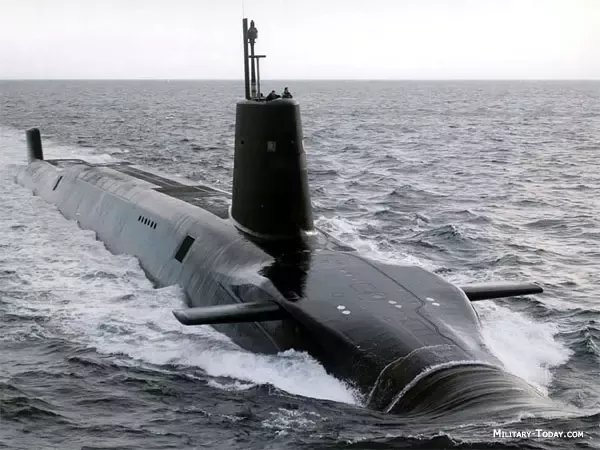
A 17,000 ton Vanguard class SSBN - each carries 16 Trident D4 ICBMs and torpedoes. Four new 18,000 ton Dreadnought class SSBNs are building, each carrying 12 Trident D5s with the ability to launch land attack cruise missiles too. The Mine Counter Measures ships are older but also advanced GRP (glass fibre) vessels, and have been regularly updated with the latest mine countermeasures technologies and combat management systems, recently received new diesel powerplants, radars and gun systems and are integrating a new Anglo-French developed offboard unmanned mine sweeping and hunting system (ARCIMS).
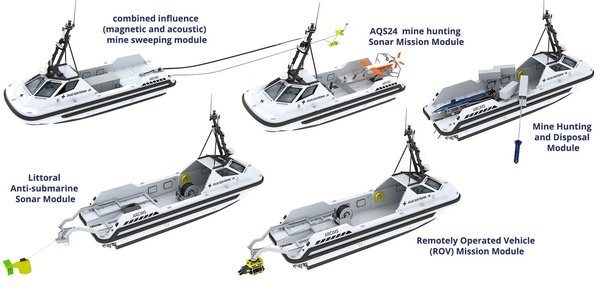
ARCIMS the Royal Navy’s new unmanned mine countermeasures system. The USVs can be launched from a variety of ships. The amphibious fleet was also renewed in the early 2000s with new large Landing Platform Docks (LPDs) and Landing Ship Docks (LSD) and is very up to date. It was recently announced that this capability will be expanded by the acquisition of two Littoral Strike Ships designed to support raiding forces. The RN has also recently completed a programme to upgrade its Merlin combat transport helicopter variants and the Amy’s current WH-64D Apache attack helicopters, and on-order AH-64Es, are all designed with folding rotor blades for ship-borne operations.
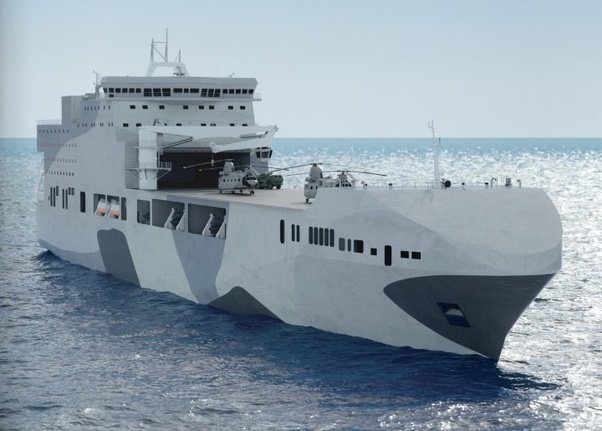
Two Littoral Strike Ships are being designed to support Royal Marines and Special Forces raiding operations. Converted from commercial hulls, they will operate helicopters, unmanned systems and assault craft and provide mobile basing and command facilities for special operations. They are likely to be forward based in the Gulf, Indian Ocean and Mediterranean. The aircraft carriers are very large (66,000 tons), brand new cutting edge ships with the latest carrier capable aircraft (F-35Bs), although they need more of them. The carriers have some novel features such as a fully automated weapons handling system that can deliver the right weapons to the aircraft hanger from the magazine autonomously. They also have two islands, allowing the ship to be commanded from the forward island - which has good visibility forward - and direct aircraft operations from the rear island - which has panoramic views over the flight deck. Each island also serves as a funnel for one of the ship’s two MT30 gas turbines, which help drive the integrated electric power system along with diesel generators located below the hangar deck. Separate islands also keep the ship’s two air search and tracking radars apart and provide redundancy for command and control in the event of battle damage.
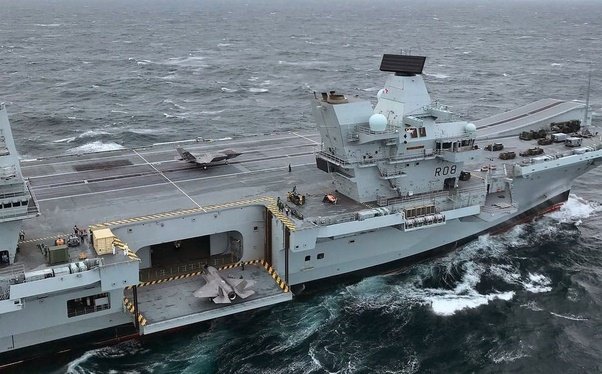
HMS Queen Elizabeth conducting trials with her F-35B Lightning stealth jets. The F-35s are operated jointly by the RAF and Fleet Air Arm and can carry Meteor beyond visual range air-to-air missiles as well a a range of air to surface weapons in an internal weapons bay. The UK is the only Tier 1 partner on the F-35 programme and Rolls Royce developed the lift-fan for the VSTOL variant. Around 15% of every F-35A and F-35C is manufactured in the UK, and 20% of the F-35B. Although the UK is committed to purchasing 138 F-35s only 42 have been ordered so far and its unclear how many will be available for carrier operations. One area where the RN lags behind is unmanned systems. There has been a lot of R&D projects for air, surface and subsurface systems, but few have entered service yet. The RN has a Fleet Air Arm squadron testing unmanned air systems which it intends to deploy eventually on escorts and aircraft carriers, and has used the Australian/US SeaScan system in the gulf on Frigates. A new ‘NavyX’ project has recently been funded to redress this imbalance.
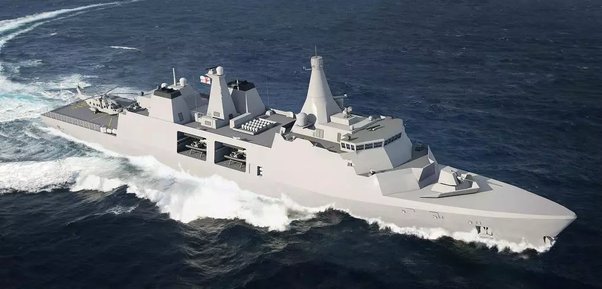
Babcock’s 4,000 ton ‘Arrowhead’ frigate, one of the three designs competing for the new Type 31e general purpose frigate contract due to be awarded later this year. These ships are designed for low-end or asymmetric combat such as counter-terrorism and counter-piracy missions. Apart from a Wildcat helicopter, their armament is primarily defensive and the sensor suite basic, although they can be upgraded to anti-submarine platforms. A few years back the RN commissioned Leonardo to build a prototype optionally-manned VSTOL system (the ‘Solo’). While its unclear if this system will be further developed, the RN has a requirement for a VSTOL UAV of this capability for the Type 26 frigates and carriers. An Anglo-French project is developing an unmanned mine countermeasures system (of which three are entering service - one to protect the nuclear submarine base at Faslane in Scotland, and two for service in the Gulf).
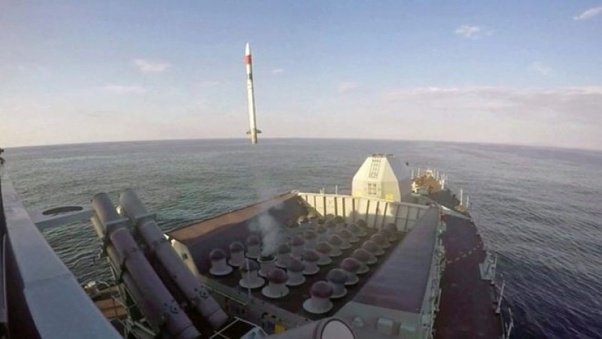
The Sea Ceptor air defence missile system is being retrofitted to Type 23 frigates during LIFEX and will be carried by new Type 26 and Type 31e frigates. Derived from the ASRAAM air-to-air missile, it has 40km range and uses a unique soft-launch system which allows it to be quad-packed in a VLS cell - increasing the number of rounds that can be carried and launched simultaneously. MBDA is developing a conventionally launched extended range (50km +) version for the Italian and Spanish navies and this might replace Aster 15 on the Type 45s in the future. The navy has also recently allocated funds to acquire an experimental extra large unmanned underwater vessel (in effect an unmanned submarine) as well as an unmanned anti-submarine warfare training system. Unmanned underwater systems are already in use for the detection and destruction of seamines and hydrographic survey tasks. The BAe/ASI Pacific 950 autonomous RIB. This arrangement can be fitted to the RN’s Pacific 24 RIBs to convert them to unmanned surface vessels to enhance surveillance in littoral environments and provide force protection against asymmetric threats.
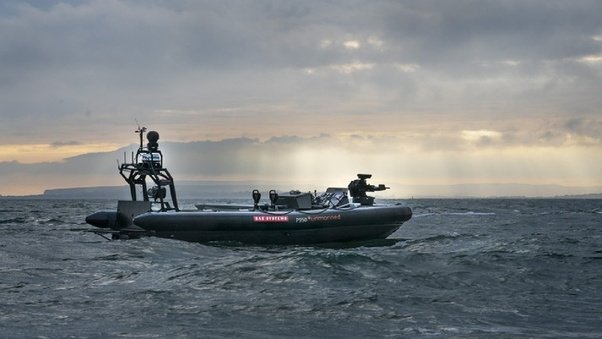
BAe and ASI defence recently trialled an unmanned surface vessel package that can be retrofitted to the Royal Navy’s Pacific 24 RIBs (most ships carry several of these). This includes the sensors, communications link and autonomous systems to task and drive the RIB and an automated weapons station for a 12.7mm HMG. Such a USV has long endurance and can be coordinated by a helicopter or from a UAS. Potentially a useful surveillance and force protection assets.
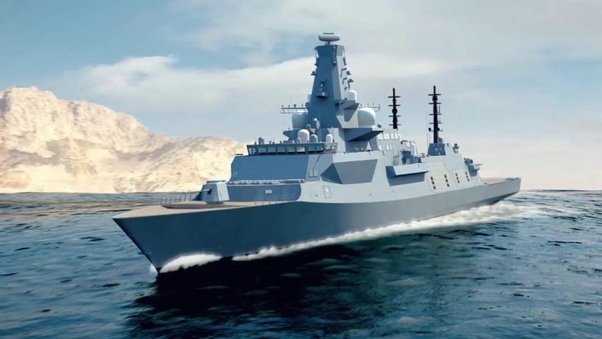
Eight 7,500 ton Type 26 ‘City’ class ASW frigates are under construction for the Royal Navy by BAe. in Glasgow. These are very advanced fleet escort platforms with a range of high-end offensive weaponry and sensors for surface attack and anti-submarine missions and sophisticated defensive weaponry and electronic countermeasures suites. Another area for improvement is the medium gun system. The RN has persevered with the Mk. 8 114mm (4.5″) automated gun system since the late 1960s, which, although they have been upgraded to Mod 1 standard in recent years, are short on range and rate of fire and lack a precision guided munition when compared to more modern systems.
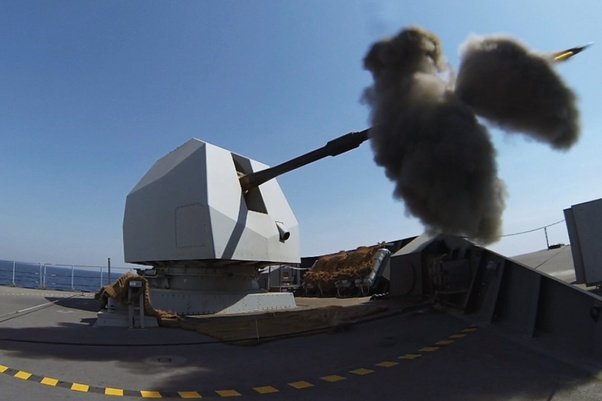
The Mk 8 Mod 1 gun, known as ‘Kryten’ in the RN due to its similarity to the Red Dwarf character. The Mk 8 has served the RN well since its introduction in 1969 but has reached the end of its development pathway. New escorts will get the BAe Mk 45 Mod 4 gun. The new Type 26 frigates will get the US developed BAe. systems Mk. 45 Mod 4 127mm (5″) gun, and its likely these will be retrofitted to Type 45 destroyers in due course. Its unclear what system the Type 31e general purpose frigates will get (there have been images with either the Type 45 or the BAe/Bofors 57mm system fitted to the USN Littoral Combat Ship).
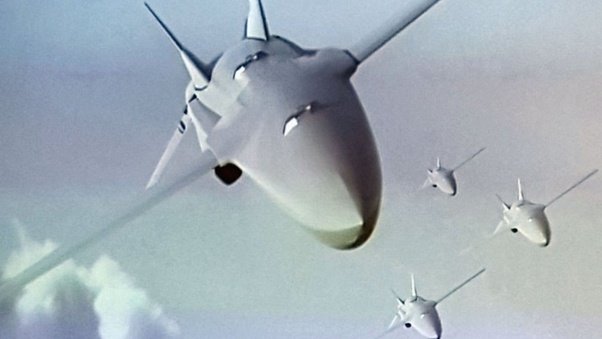
Project Mosquito is developing a low-cost autonomous unmanned system to operate with the F-35s and future RAF project Tempest 6th generation aircraft. Its envisaged that these UCAVs will operate from the Royal Navy’s carriers alongside the F-35Bs. They could have kinetic strike, electronic warfare (including cyber attack), surveillance and air defence capabilities. There are more R&D projects underway to develop directed energy (laser) weapons, including the Dragonfire CIWS. The RN will also benefit from the RAF-led Mosquito project for unmanned air systems to operate with the F-35s from the carriers as so called ‘loyal wingmen’. New long-range supersonic (and possibly hypersonic) antiship and cruise missiles are funded or under R&D too.
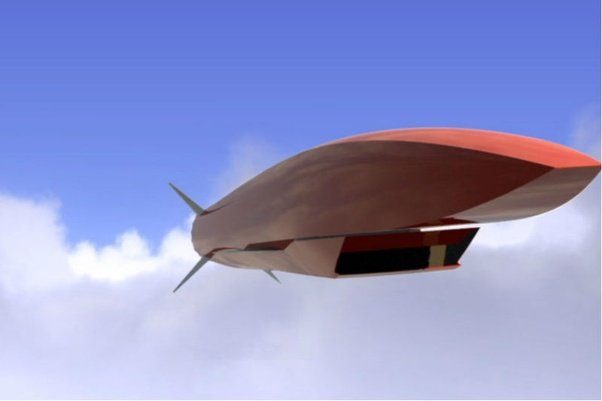
Perseus is MBDA’s concept for a future hypersonic cruise/anti-ship missile under joint development by Britain and France. It will be both air and sea launched and replace Tomahawk and Storm Shadow cruise missiles as well as ship and submarine launched anti-ship missiles. It was recently announced that the RN will procure an off-the-shelf interim anti-ship missile to replace its ageing Harpoon systems while these more advanced systems are under development: the Kongsberg/Raytheon Naval Strike Missile or Lockheed Martin Long Range Anti Ship Missile are likely candidates, although its possible that the latest version of Harpoon might be bought for the Type 23s. SAAB’s RBS-15 and MBDA’s lates Exocet variant are outside choices.
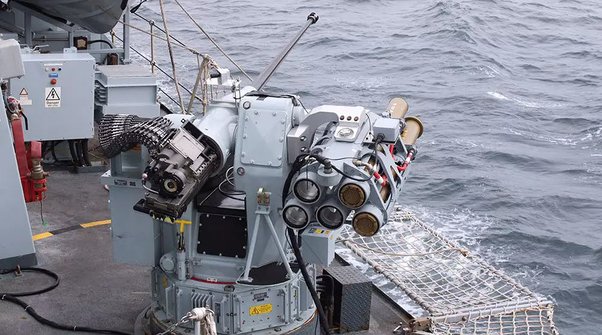
All of the RN’s larger warships and many smaller ones are fitted with DS30M automated 30mm gun systems for protection against swarming small boat attacks. A version fitted with the Martlet Lightweight Multirole Missile (which extends the DS30M system’s range out to 6km) was recently tested, and this upgrade is likely to fitted to RN ships in future. All RN ships have been given much improved self-protection systems in recent years. These range from soft-kill electronic countermeasures (jammers), decoys and chaff dispensers to hard kill systems such as the DS30M automated 30mm bushmaster gun system (which is being integrated with Martlet missiles), the Sea Ceptor 40km range point air defence missile, as well as upgraded 20mm Phalanx CIWS for protection against sea-skimiming missiles and 7.62 miniguns for use against small boats. Two of the Type 45 Destroyers have sophisticated electronic intelligence gathering systems fitted too.
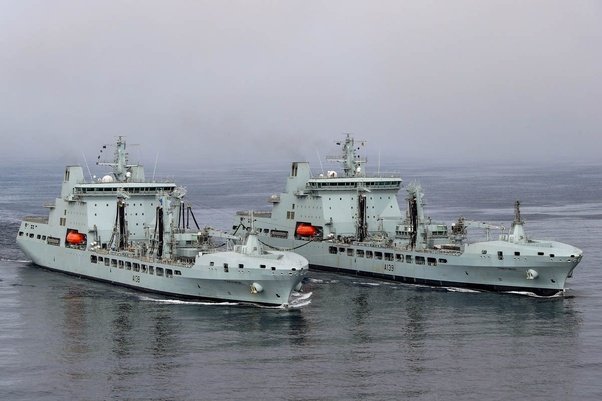
Two of the Royal Fleet Auxiliary’s Tide-class 37,000 ton replenishment tankers. The RFA has six large tankers in total. 3 new fleet solid support vessels - designed to deliver ammunition and dry stores to warships - are due to be ordered shortly. As far as support ships go, the replenishment tanker fleet is large and up to date and although the fleet solid support ships are older, they are due to be replaced by new ships in the next few years. The survey ships and offshore patrol vessels are modern and up to date and there is a much modernised specialist vessel for helicopter training and casualty clearance (in effect a floating field hospital) and an icebreaker for service in the Antarctic.
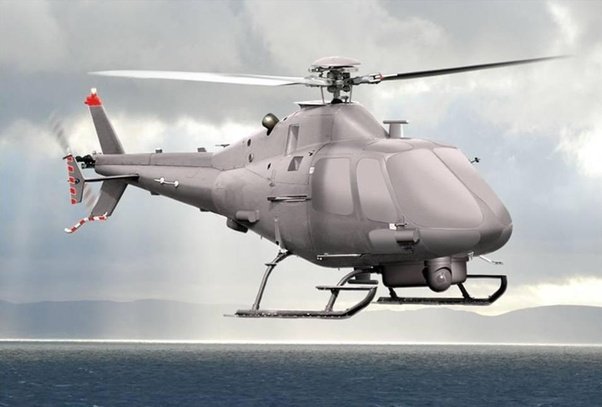
The Leonardo ‘Solo’ VSTOL UAS concept for a the Royal Navy. A technology demonstrator has flown already. As well as improving situational awareness, these unmanned systems can also drop sonar buoys and carry torpedoes and lightweight missiles. They can be tasked by their parent ship or from a Wildcat or Merlin helicopter. The RAF is responsible for shore-based maritime aircraft and this capability lapsed after the Nimrod MRA4 maritime patrol aircraft was cancelled during the 2010 strategic defence review - a major miscalculation that was reversed in 2015. The RAF is now receiving Boeing P-8A Poseidon aircraft from the USA and may get a maritime variant of the Protector unmanned surveillance aircraft in due course.
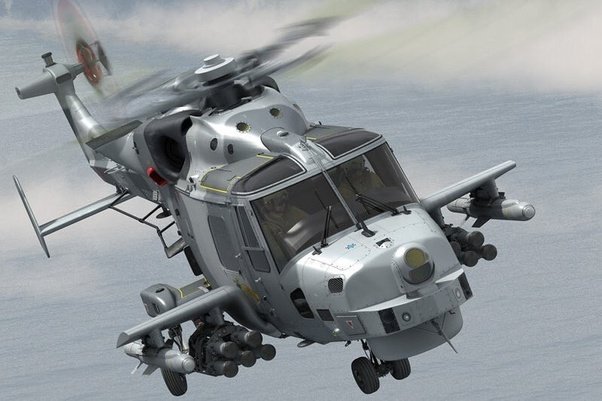
Royal Navy Wildcat helicopters provide a surface attack capability for escorts. Armed with Sea Venom and Martlet missiles they have a sophisticated suite of sensors including a 360 degree radar, electro-optical turret and passive electronic intelligence gathering devices. Their datalink and combat system allows them receive and feed information directly from and to the ships combat management system and control and integrate data gathered by unmanned systems. The Royal Navy operates modified Merlin helicopters in the combat transport and combat rescue role in support of the Royal Marines, and some Wildcats in the RM support role too. RAF Chinook medium lift helicopters and Army Apache attack helicopters are also operated from the Navy’s amphibious ships and carriers. All of the Royal Navy, Army and RAF’s helicopters are about to receive a new generation of high-spec eletro-optical turrets.
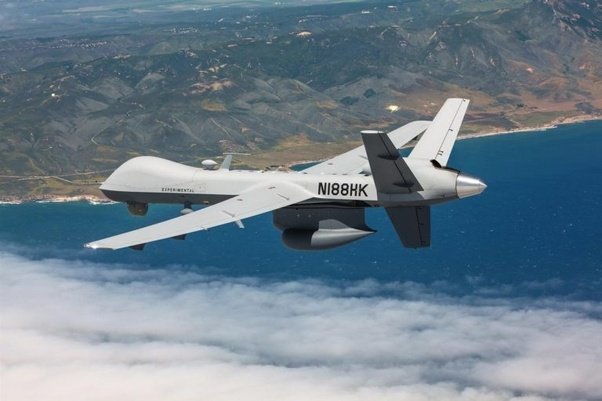
A maritime patrol version of the Protector UAS (the General Atomics MQ-9B Sea Guardian) has been developed integrating a UK designed radar. The strike version of the Protector is on order for the RAF and it has been speculated that some maritime patrol variants will be ordered in due course to work with the P-8As. Maritime search and rescue was a Royal Navy and RAF responsibility until recently, when it was handed over to HM Coastguard. The Coastguard have refreshed the SAR helicopter fleet with new Sikorsky S-92 and Leonardo AW-139 and AW-189 rescue helicopters. The RAF provides C-130s to support long-range SAR and operates a number of AW-139s to provide SAR training for RN and RAF helicopter aircrews, while the Coastguard also operate fixed wing radar and infra-red camera equipped Jetstream 41 and Cessna Caravan II aircraft for coastal surveillance and SAR.
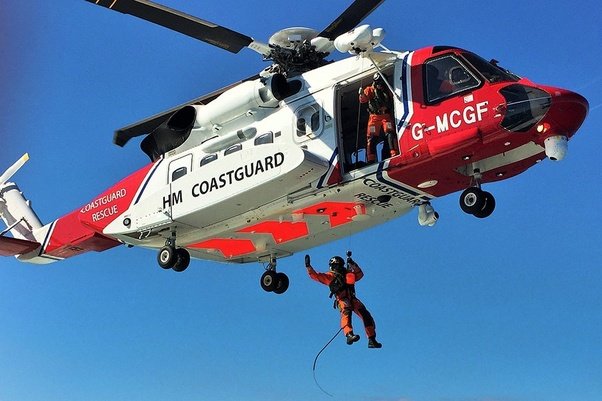
One of HM Coastguard’s S-92 MR long-range search and rescue helicopters. Coastguard S-92s and AW-139/189 rescue helicopters are deployed around the UK coastline and on the Falkland Islands. RAF Griffin helicopters provide SAR for the RAF base at Akrotiri in Cyprus and RN Merlins provide a combat rescue service for all three services. Working with vessels operated by the Scottish Fishery Protection Service, HM Coastguard and HM Border Force, the Royal Navy’s offshore patrol vessels help protect Britain’s maritime borders and offshore assets as well as conducting counter-narcotics, counter-piracy and counter-terrorism tasks. These new ships can also carry out humanitarian relief and search and rescue missions.
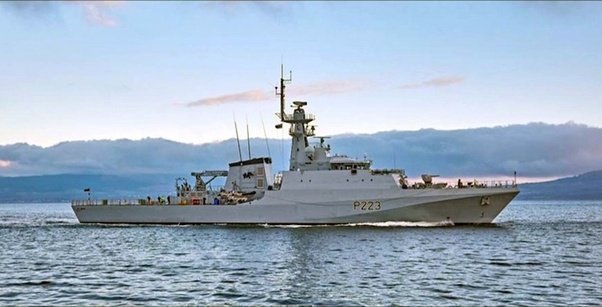
HMS Medway, a River-class Batch 2 Patrol Vessel, delivered to the RN this year. One ship is permanently deployed to the Falkland Islands along with the ice patrol ship HMS Protector and two inshore patrol craft. Offshore and inshore patrol craft are also based in the UK, where they also support the Royal Navy’s officer and university cadet training schemes, and at Gibraltar and Cyprus. While the Royal Navy needs to sustain its technological advantage over potential adversaries, it critically needs more volume, especially submarines, escorts and aircraft (fixed wing, helicopters and UAS). Some of this could be made up by using autonomous unmanned systems (which reduce the requirement for more manpower), and ‘NavyX’, the Solo UAV, ARCIMS, “Project Mosquito” and unmanned submarine initiatives could really help bulk out the fleet air arm, mine countermeasures and submarine fleets and add capability to surface ships. Nevertheless the Royal Navy needs more escorts and fast jets, and one can only hope that more Type 26 and/or Type 31e frigates and F-35Bs will be ordered.
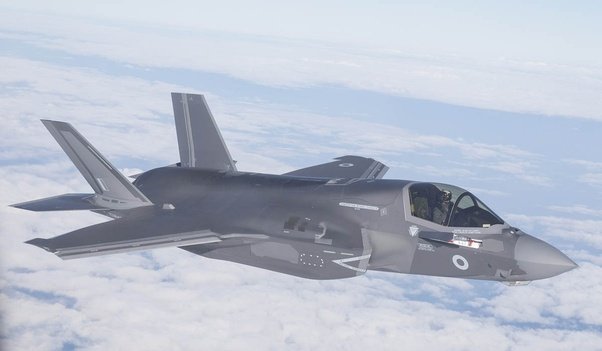
More F-35s are required to enable the Royal Navy’s carrier strike potential to be realised. F-35s are optimised for fleet air defence, strike and ISTAR missions. They carry ASRAAM and Meteor air-to-air missiles, Paveway IV precision guided bombs and will be integrated with new Spear 3 100km range air to surface missiles and a future cruise and anti-ship missile in due course. If more cash becomes available a nice to have would be an in-flight refuelling capability to extend the range of the F-35s and Merlins and Chinooks deployed on the carriers and littoral strike ships. The MV-22 Osprey fits the bill, and would also provide the Fleet Air Arm with a longer ranged tactical transport capability for carrier on board delivery and to support littoral strike operations. The MV-22 is the only aircraft in service that can carry a complete replacement engine for a F-35 and land on a carrier.
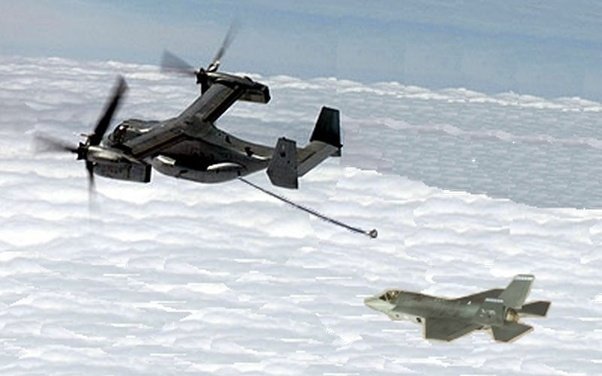
“Nice to have but unlikely to get”. MV-22 tilt-rotor tanker-transports would prove useful force-multipliers for the carriers. In addition to the F-35Bs, they could refuel RN Merlins and RAF Chinooks, both of which types are fitted ‘for but not with’ refuelling probes. 23.9k views · View Upvoters